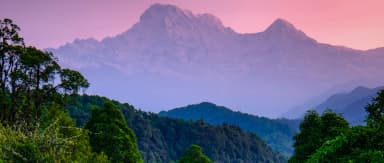The Future of Climate Solutions: India's Blue Carbon Potential
21 October 2024
New Delhi
Published on: 10/21/2024

This June was the warmest on record so far. It also marked the 12th consecutive month with global temperatures reaching 1.5 degrees Celsius above the pre-industrial average.
This warming of the planet is related—directly or indirectly—to widespread habitat loss on both land and in the sea & biodiversity of flora and fauna. Studies have found that biodiversity around the world has likely declined by 2–11 per cent, with climate change as the main driver of this decline. India, as the fastest-growing major economy, has the unique challenge and incredible opportunity to sustain its growth while addressing the climate crisis through innovation and building a future-proof nation.
To do this, it is crucial we use all resources at our disposal, with blue carbon being a solution that is hidden in plain sight.
Understanding Blue Carbon Ecosystems
The ocean plays a vital role in battling climate change. It acts like a giant filter, constantly pulling carbon dioxide out of the air and storing it within its depths. This natural process helps keep a significant amount of carbon out of the atmosphere, where it would otherwise contribute to global warming.
Blue carbon ecosystems primary include mangroves, tidal and salt marshes and seagrasses. India is blessed with a 7,500+ kilometre-long coastline. Research has found that India could presently have about 5,000 sq. km. of mangroves, 500 sq. km. of seagrasses, and anywhere between 300 to 1400 sq. km. of salt marshes, which cumulatively adds up to about 0.5 percent of the country’s total area. This presents an incredible opportunity for India to build its capabilities and explore new horizons in managing these carbon sinks.
However, a pervasive myth endures that the ocean can endure any human impact. The truth is the health of blue-carbon ecosystems is crucial, and their degradation significantly undermines this natural defence against climate change. We should acknowledge the ocean's vulnerability and implement measures to protect these essential carbon sinks.
Mangrove restoration: Setting the stage for adaptation & mitigation with
The Sundarbans, a vast delta that spans 10,000 square kilometres and divides the Indian states of West Bengal and Bangladesh, are home to the largest mangrove swamp forest in the world. A recent global assessment by the International Union for Conservation of Nature (IUCN) revealed that more than 50 per cent of mangrove ecosystems are on the verge of collapse due to a combination of human activities and climate change, including sea-level rise and an increased frequency and severity of cyclonic storms.
Ensuring restoration of mangroves will be critical in setting the stage for effective climate adaptation and mitigation efforts in the country. Mangroves not only have exceptional carbon sequestration abilities, but they have also guarded local communities and their livelihoods for ages. They act as a barrier to seawater abrasion and reduce the risk of floods, the frequency of which has increased drastically in the past few years. This is especially true in the case of India.
Best foot forward for India
Multi-stakeholder efforts to identify and restore historical mangrove areas that are in degraded condition are the need of the hour. End-to-end participation of local communities in the planning and execution of these projects will play an important role as they have an entrenched understanding of the ecosystem. By leveraging their generational knowledge, we can understand how these ecosystems will react to interventions and develop localised solutions.
By launching pilot projects with the private sector, civil society, & academia, the centre could look at a strategic mission that streamlines technological development with financial & policy interventions. A robust carbon market in the country could be a critical element of this journey.
Globally, the protection and restoration of blue carbon has been gaining prominence as a key natural climate solution. While the dialogue on mangroves has gained momentum in the realms of coastal protection in our country, the mangrove-blue carbon finance dimension remains untapped and full of potential. Our commitment to the 2070 net-zero targets entails that we explore all potential interventions and leverage them to their fullest.
-Kavin Kumar Kandasamy is the CEO of ProClime.
News Article Link: https://www.outlookbusiness.com/planet/opinions/the-future-of-climate-solutions-indias-blue-carbon-potential
Proclime : [email protected]
Related News & Media



